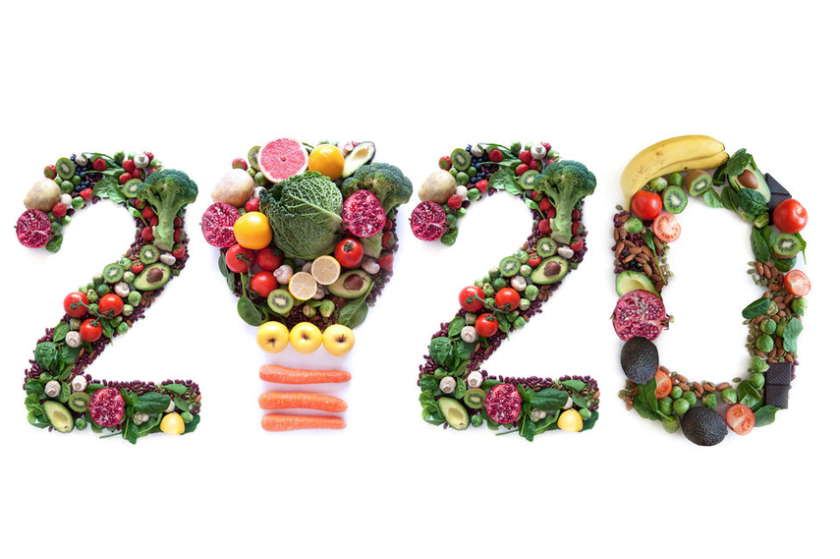
Happy New Year! 2020 is well underway. Can you say the same for your New Year’s resolutions? If so, good for you! Unfortunately, the statistics are not on your side. Most people give up on their resolutions by January 12. If that’s you, don’t feel bad. This does not mean that you are weak-willed or have set more lofty goals than you should.
Most likely, your resolution requires willpower. And that’s just not what gets things done. What you really need is the power of good habits. That is what Dr. C gives us in this article: good, solid guidelines and habits that you can establish to make your diet healthier automatically! Healthy habits are built-in resolution reinforcements!
Buy your snacks at the farmer’s market. Yes, this tip is definitely a recommendation for buying whole fruits and vegetables for snacks. But you can also splurge a little bit at the farmer’s market and buy fresh pastries or cookies. Limit yourself to one and eat it while you are strolling around in the sunshine. This means you can indulge a bit, not feel deprived, but also not have lots of temptations lurking around the house. Hand-crafted baked goods from the farmer’s market tend to contain less preservatives (if any) and more wholesome ingredients than the packaged snack goods at the grocery store.
Drink the spinach water! What does this mean? The next time you boil or steam fresh veggies, don’t throw away the water! There are nutrients in that water and you can use it as a base for soups, stews, green smoothies or any other dish that requires water as a first ingredient. If you buy organic produce, this is an even better way to get more bang for your buck.
Eat traditional foods. Everyone would be much healthier if they ate more Asian, Greek, French, Italian or Mexican food. Do you see where we’re headed? The secret is eating these foods the way they were traditionally meant to be eaten. “Americanized” versions of these foods tend to contain mineral-depleted sodium, sugar, trans fats and preservatives, which are toxic and inflammatory to your body. Traditional foods contain antioxidant-rich herbs and spices, nutrient-dense whole fruits and veggies, heart-healthy fats and protein-packed cuts of meat. And the biggest difference? Cooking at home of course! That is the only way you will know 100% of what is in your meal. If you want to learn how to cook healthy food faster at home, join us for our next in-office Healthy Eating & Living Event on Thursday, February 6.
Sweeten and salt your food yourself. Following from the tip above, it’s always better to choose your own sweeteners and salts. There are many sugar alternatives that do not spike blood sugar, but not everyone in your family will enjoy the same substitute. Some people hate the taste of stevia. Xylitol tastes more like sugar, but some people experience gastrointestinal distress after eating it. Erythritol is usually well-tolerated. Monk fruit and agave are also alternatives. Unfortunately, many of these options are highly-processed so pay attention to the quality and buy only reputable brands. To make things simpler, maybe all you need is a teaspoon a fresh local honey in your tea or coffee!
Unless directed otherwise by your physician, getting enough salt is important to nourish your adrenals and add electrolytes back to your body, especially if you are physically active. Regular iodized salt is missing important trace minerals that you’d find in sea salt. Food processors use iodized salt because it is a cheaper ingredient, and also often overdo it. When you sweeten and salt your food yourself, you have control over a small aspect of your health that can make a big difference over time.
Plant a Juice Plus+ Tower Garden®. There is nothing better for your health than produce picked and eaten within minutes. Also, fresh-picked just tastes better! The produce in your grocery store may have traveled thousands of miles and taken days to get to you. Plus, the vitamin content of fruits and vegetables begins to decline immediately after they are picked. Here in Central Florida, vegetable gardening can be a little tough, especially if you are accustomed to the shorter, but cooler and less bug-infested gardening season up north. Florida vegetable gardening takes a bit more looking after and patience if you want to harvest your crops! A Juice Plus+ Tower Garden® makes it simpler to enjoy the fruits of your labor. 🙂 It is a gardening system that uses the same technology as NASA! It is soil-free, can be used year-round and grows over 150 types of plants. If you want more information, call the office and ask for assistance. Carol Ann (Dr. C’s lovely bride) will answer all your questions and get you started!
We hope these tips are helpful and encourage you to think about other healthy habits you can start instead of making resolutions that feel restrictive and unreachable. Do you already have an awesome tip that works for you and your family? Click here to share and maybe your tip will appear in the next newsletter!
Image copyright: 123rf.com/pixelbliss





